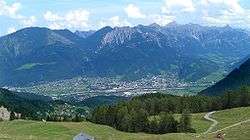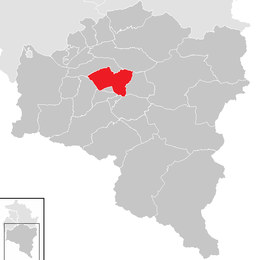Bludenz
| Bludenz | ||
|---|---|---|
|
View from southwest | ||
| ||
 Bludenz Location within Austria | ||
Location in the district
| ||
| Coordinates: 47°08′00″N 09°49′00″E / 47.13333°N 9.81667°ECoordinates: 47°08′00″N 09°49′00″E / 47.13333°N 9.81667°E | ||
| Country | Austria | |
| State | Vorarlberg | |
| District | Bludenz | |
| Government | ||
| • Mayor | Josef Katzenmayer (ÖVP) | |
| Area | ||
| • Total | 30.0 km2 (11.6 sq mi) | |
| Elevation | 588 m (1,929 ft) | |
| Population (1 January 2016)[1] | ||
| • Total | 14,118 | |
| • Density | 470/km2 (1,200/sq mi) | |
| Time zone | CET (UTC+1) | |
| • Summer (DST) | CEST (UTC+2) | |
| Postal code | 6700 | |
| Area code | 05552 | |
| Vehicle registration | BZ | |
| Website | Official website | |
Bludenz is a town in the Austrian state of Vorarlberg. It is the administrative seat of Bludenz District, which encompasses about half of the state's territory.
Geography
The town is located on the Ill River, a direct tributary of the Rhine. It is surrounded by the ranges of the Bregenz Forest Mountains in the north, and by the Rätikon and Silvretta ranges in the south. Bludenz lies at the meeting point of five valleys: Walgau and Montafon (Ill), Brandnertal, Klostertal up to Arlberg Pass, and Großes Walsertal.
Bludenz is a popular hiking and mountain-biking resort in the summer months, located on the way to many nearby skiing resorts (e.g., Brand[2] and Lech[3]). Due to the A14 Rheintal/Walgau Autobahn with its southeastern terminus in Bludenz, the name of the town is well known in Austria.
Major companies are Mondelēz International (Milka chocolate) and Fohrenburger[4] (beer, 5.2% alcohol).

History
Archaeological finds indicate settlement in the area of Bludenz began in the Bronze Age,[5] lasting up to the La Tène era. The name Bludenz originates from the Celts. In 600 BC there was a military training ground of the Romans.
Bludenz itself was first mentioned in an 830 urbarium of the Raetian estates within the Carolingian Empire. The town was established by the comital Werdenberg dynasty, town privileges were granted in 1274. A stay of the Habsburg duke Frederick IV of Austria, who had just received an Imperial ban at the Council of Constance, is documented on 30 March 1416. Four years later, Bludenz passed to the Further Austrian possessions of the Habsburg dynasty.
Over the years, churches and castles were built in the city. The Bludenz district headquarters are situated in the Castle of Gayenhofen, built in the 18th century.
Population
| Historical population | ||
|---|---|---|
| Year | Pop. | ±% |
| 1869 | 2,466 | — |
| 1880 | 3,151 | +27.8% |
| 1890 | 4,501 | +42.8% |
| 1900 | 5,361 | +19.1% |
| 1910 | 5,870 | +9.5% |
| 1923 | 6,019 | +2.5% |
| 1934 | 7,738 | +28.6% |
| 1939 | 7,738 | +0.0% |
| 1951 | 10,178 | +31.5% |
| 1961 | 11,127 | +9.3% |
| 1971 | 12,273 | +10.3% |
| 1981 | 12,891 | +5.0% |
| 1991 | 13,369 | +3.7% |
| 2001 | 13,701 | +2.5% |
| 2011 | 13,726 | +0.2% |
References
- ↑ Statistik Austria - Bevölkerung zu Jahresbeginn 2002-2016 nach Gemeinden (Gebietsstand 2016-01-01), 2016-01-01.
- ↑ (German) Brand website
- ↑ (German) Lech website
- ↑ (German) Fohrenburger website
- ↑ (German) Infos at Bludenz website
External links
![]() Media related to Bludenz at Wikimedia Commons
Media related to Bludenz at Wikimedia Commons
- (German) Bludenz official website


